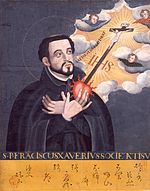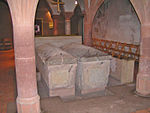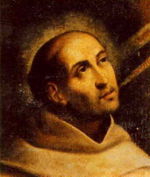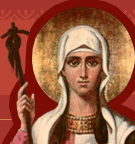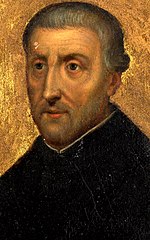Portal:Catholic Church/Patron Archive/December
Patron Archive
January - February - March - April - May - June - July - August - September - October - November - December
Today is Friday, November 22, 2024; it is now 19:07 UTC
Eligius (French: Éloi; 11 June 588 – 1 December 660), venerated as Saint Eligius, was a Frankish goldsmith, courtier, and bishop who was chief counsellor to Dagobert I and later Bishop of Noyon–Tournai. His deeds were recorded in Vita Sancti Eligii, written by his friend Audoin of Rouen.
Born into a Gallo-Roman family, Eligius found success as a goldsmith at the Merovingian royal court of Clotaire II and served as chief counsellor to Dagobert I until Dagobert's death in 639. Under the subsequent regency of Nanthild, the queen consort, Eligius was ordained a priest and campaigned against simony in the Church. Appointed Bishop of Noyon–Tournai in 642, he founded many monasteries and churches while working to convert the pagan population of Flanders to Christianity. (Full article...)
Attributes: bishop with a hammer, anvil, and horseshoe
Patronage: cartwrights; clock/watch makers; coin collectors; craftsmen of all kinds; cutlers; gilders; goldsmiths; harness makers; horses; jewelers; jockeys; knife makers; laborers; locksmiths; metalworkers in general; miners; minters; Royal Electrical and Mechanical Engineers; saddlers; tool makers
See also: Alexander Briant, England; Edmund Campion, England; Thomas Garnet, England; Ralph Sherwin, England
Saint Bibiana (Bibiane, Viviana, or Vivian) is a Roman Virgin martyr. The earliest mention in an authentic historical authority occurs in the Liber Pontificalis, where the biography of Pope Simplicius (468–483) states that this pope "consecrated a basilica of the holy martyr Bibiana, which contained her body, near the 'palatium Licinianum'" (ed. Duchesne, I, 249). The Basilica of Santa Bibiana is dedicated to her. (Full article...)
Attributes: column and scourge with leaded thongs; branch of a tree; dagger; scourge; depicted tied to a column
Patronage: parish, epilepsy, epileptics, hangovers, headaches, insanity, mental illness, mentally ill people, single laywomen, torture victims
Francis Xavier, SJ (born Francisco de Jasso y Azpilicueta; Latin: Franciscus Xaverius; Basque:Xabierkoa; French: François Xavier; Spanish: Francisco Javier; Portuguese: Francisco Xavier; 7 April 1506 – 3 December 1552), venerated as Saint Francis Xavier, was a Basque cleric. He was a Catholic missionary and saint who co-founded the Society of Jesus and, as a representative of the Portuguese Empire, led the first Christian mission to Japan.
Born in the town of Xavier, Kingdom of Navarre, he was a companion of Ignatius of Loyola and one of the first seven Jesuits who took vows of poverty and chastity at Montmartre, Paris in 1534. He led an extensive mission into Asia, mainly the Portuguese Empire in the East, and was influential in evangelization work, most notably in early modern India. He was extensively involved in the missionary activity in Portuguese India. In 1546, Francis Xavier proposed the establishment of the Goan Inquisition in a letter addressed to King John III of Portugal. While some sources claim that he actually asked for a special minister whose sole office would be to further Christianity in Goa, others disagree with this assertion. As a representative of the king of Portugal, he was also the first major Christian missionary to venture into Borneo, the Maluku Islands, Japan, and other areas. In those areas, struggling to learn the local languages and in the face of opposition, he had less success than he had enjoyed in India. Xavier was about to extend his mission to Ming China, when he died on Shangchuan Island. (Full article...)
Attributes: Crucifix; preacher carrying a flaming heart; bell; globe; vessel; young bearded Jesuit in the company of Saint Ignatius Loyola; young bearded Jesuit with a torch, flame, cross and lily
Patronage: African missions; Agartala, India; Ahmedabad, India; Alexandria, Louisiana; Apostleship of Prayer; Australia; Bombay, India; Bengaluru, India; Borneo; Cape Town, South Africa; China; Dinajpur, Bangladesh; East Indies; Fathers of the Precious Blood; foreign missions; Freising, Germany; Goa, India; Green Bay, Wisconsin; India; Indianapolis, Indiana; Key West, Florida; Sophia University, Tokyo, Japan; University of Saint Francis Xavier; Sucre, Bolivia; Joliet, Illinois; Kabankalan, Philippines; Nasugbu, Batangas, Philippines; Abuyog, Leyte, Philippines; Alegria, Cebu, Philippines; Macau; Madagascar; diocese of Malindi, Kenya; missionaries; Missioners of the Precious Blood; Navarre, Spain; navigators; New Zealand; parish missions; plague epidemics; Propagation of the Faith; Zagreb, Croatia; Indonesia; Malacca; Malaysia; Mongolia; Sri Lanka
Saint Barbara (Ancient Greek: Ἁγία Βαρβάρα; Coptic: Ϯⲁⲅⲓⲁ Ⲃⲁⲣⲃⲁⲣⲁ; Church Slavonic: Великомученица Варва́ра Илиопольская; Arabic: القديسة الشهيدة بربارة), known in the Eastern Orthodox Church as the Great Martyr Barbara, was an early Christian Greek saint and martyr. There is no reference to her in the authentic early Christian writings nor in the original recension of Saint Jerome's martyrology. (Full article...)
Prayer: Oh God, who among the other miracles of Your power, have given the victory of martyrdom, grant, we beseech You, that we, who are celebrating the heavenly Blessed Barbara, Your Virgin and Martyr, may by her example draw nearer to you. Amen
Attributes: Three-windowed tower, palm, chalice, lightning, a crown of martyrdom
Patronage: Armourers, Architects, Artillerymen, Firemen, Mathematicians, Miners, Tunnellers, Chemical Engineers, Prisoners, Russian Missile Strategic Forces
See also: Clement of Alexandria; John of Damascus; Giovanni Calabria
Sabas (439–532), in Church parlance Saint Sabas or Sabbas the Sanctified (Greek: Σάββας ὁ Ἡγιασμένος), was a Cappadocian Greek monk, priest, grazer and saint, who was born in Cappadocia and lived mainly in Palaestina Prima. He was the founder of several convents, most notably the one known as Mar Saba, in Palestine. The saint's name is derived from Imperial Aramaic: סַבָּא Sabbāʾ "old man". (Full article...)
Attributes: Clothed as a monk, often holding a paterissa (abbot's staff)
Patronage: -
See also: Gerald of Braga; John Almond
Saint Nicholas of Myra (traditionally 15 March 270 – 6 December 343), also known as Nicholas of Bari, was an early Christian bishop of Greek descent from the maritime city of Patara in Anatolia (in modern-day Antalya Province, Turkey) during the time of the Roman Empire. Because of the many miracles attributed to his intercession, he is also known as Nicholas the Wonderworker. Saint Nicholas is the patron saint of sailors, merchants, archers, repentant thieves, children, brewers, pawnbrokers, toymakers, unmarried people, and students in various cities and countries around Europe. His reputation evolved among the pious, as was common for early Christian saints, and his legendary habit of secret gift-giving gave rise to the folklore of Santa Claus ("Saint Nick") through Sinterklaas. (Full article...)
Prayer: Glorious St. Nicholas, my special patron, from thy throne in glory, where thou dost enjoy the presence of God, turn thine eyes in pity upon me and obtain for me from our Lord the graces and helps that I need in my spiritual and temporal necessities (and especially this favor [petition or intercede here], provided that it be profitable to my salvation). Be mindful, likewise, O glorious and saintly Bishop, of our Sovereign Pontiff, of Holy Church, and of all Christian people. Bring back to the right way of salvation all those who are living steeped in sin and blinded by the darkness of ignorance, error, and heresy. Comfort the afflicted, provide for the needy, strengthen the fearful, defend the oppressed, give health to the infirm; cause all men to experience the effects of thy powerful intercession with the supreme Giver of every good and perfect gift. Amen.
(Our Father, Hail Mary, Glory Be)
V. Pray for us, O blessed Nicholas.
R. That we may be made worthy of the promises of Christ.
Let us pray. O God, who has glorified blessed Nicholas, Thine illustrious Confessor and Bishop, by means of countless signs and wonders, and who dost not cease daily so to glorify him; grant, we beseech Thee, that we, being assisted by his merits and prayers, may be delivered from the fires of hell and from all dangers. Through Christ our Lord. Amen.
Attributes: Vested as a Bishop. In Eastern Christianity, wearing an omophorion and holding a Gospel Book. Sometimes shown with Jesus Christ over one shoulder, holding a Gospel Book, and with the Theotokos over the other shoulder, holding an omophorion.
Patronage: Children, coopers, sailors, fishermen, merchants, broadcasters, the falsely accused, repentant thieves, brewers, pharmacists, archers, pawnbrokers, Aberdeen, Galway, Russia, Greece, Hellenic Navy, Liverpool, Bari, Siggiewi, Moscow, Amsterdam, Lorraine, Royal School of Church Music and Duchy of Lorraine, students in various cities and countries around Europe
See also: Carmen Salles y Barangueras
Ambrose of Milan (Latin: Aurelius Ambrosius; c. 339 – 4 April 397), venerated as Saint Ambrose, was a theologian and statesman who served as Bishop of Milan from 374 to 397. He expressed himself prominently as a public figure, fiercely promoting Roman Christianity against Arianism and paganism. He left a substantial collection of writings, of which the best known include the ethical commentary De officiis ministrorum (377–391), and the exegetical Exameron (386–390). His preaching, his actions and his literary works, in addition to his innovative musical hymnography, made him one of the most influential ecclesiastical figures of the 4th century.
Ambrose was serving as the Roman governor of Aemilia-Liguria in Milan when he was unexpectedly made Bishop of Milan in 374 by popular acclamation. As bishop, he took a firm position against Arianism and attempted to mediate the conflict between the emperors Theodosius I and Magnus Maximus. Tradition credits Ambrose with developing an antiphonal chant, known as Ambrosian chant, and for composing the "Te Deum" hymn, though modern scholars now reject both of these attributions. Ambrose's authorship on at least four hymns, including the well-known "Veni redemptor gentium", is secure; they form the core of the Ambrosian hymns, which includes others that are sometimes attributed to him. He also had a notable influence on Augustine of Hippo (354–430), whom he helped convert to Christianity. (Full article...)
Attributes: Beehive, a child, whip, bones
Patronage: Bee keepers; bees; bishops; candle makers; domestic animals; French Commissariat; geese; learning; livestock; Milan; police officers; students; wax refiners
See also: Maria Giuseppa Rossello
Saint Eucharius is venerated as the first bishop of Trier. He lived in the second half of the 3rd century. (Full article...)
Attributes: devil, dragon or hellhound
Patronage: Treves
Juan Diego Cuauhtlatoatzin, also known simply as Juan Diego (Spanish pronunciation: [ˌxwanˈdjeɣo]; 1474–1548), was a Nahua peasant and Marian visionary. He is said to have been granted apparitions of Our Lady of Guadalupe on four occasions in December 1531: three at the hill of Tepeyac and a fourth before don Juan de Zumárraga, then the first bishop of Mexico. The Basilica of Our Lady of Guadalupe, located at the foot of Tepeyac, houses the cloak (tilmahtli) that is traditionally said to be Juan Diego's, and upon which the image of the Virgin is said to have been miraculously impressed as proof of the authenticity of the apparitions. (Full article...)
Attributes: tilma
Patronage: Indigenous peoples
See also: Peter Fourier, France
Eulalia of Mérida (Augusta Emerita in 292 - Augusta Emerita 10 December, 304) was a young Roman Christian martyred in Augusta Emerita, the capital of Lusitania (modern Mérida, Spain), during the Persecution of Christians under Diocletian. Other views place her death at the time of Trajan Decius (AD 249–51). There is debate whether Saint Eulalia of Barcelona, whose story is similar, is the same person. Up till the proclamation of James, son of Zebedee, Eulalia was invoked as the protector of Christian troops in the Reconquista and was patron of the territories of Spain during their formation. (Full article...)
Attributes: cross, stake, and dove
Patronage: Mérida, Spain; Oviedo, Spain; runaways; torture victims; widows; inclement weather
See also: Gemellus of Ancyra; Edmund Gennings, England; Polydore Plasden, England
Pope Damasus I (/ˈdæməsəs/; c. 305 – 11 December 384), also known as Damasus of Rome, was the bishop of Rome from October 366 to his death in 384. He presided over the Council of Rome of 382 that determined the canon or official list of sacred scripture. He spoke out against major heresies (including Apollinarianism and Macedonianism), thus solidifying the faith of the Catholic Church, and encouraged production of the Vulgate Bible with his support for Jerome. He helped reconcile the relations between the Church of Rome and the Church of Antioch, and encouraged the veneration of martyrs. (Full article...)
Attributes: as a pope with patriarchal cross and model of a church
Patronage: Archaeologists, against fever
See also: Maravillas de Jesús, Spain
Finnian of Clonard ('Cluain Eraird') – also Finian, Fionán or Fionnán in Irish; or Finianus and Finanus in its Latinised form (470–549) – was one of the early Irish monastic saints, who founded Clonard Abbey in modern-day County Meath. The Twelve Apostles of Ireland studied under him. Finnian of Clonard (along with Enda of Aran) is considered one of the fathers of Irish monasticism. (Full article...)
Attributes: -
Patronage: Diocese of Meath
Lucia of Syracuse (283–304 AD), also called Saint Lucia (Latin: Sancta Lucia) (and better known as Saint Lucy) was a Roman Christian martyr who died during the Diocletianic Persecution. She is venerated as a saint in Catholic, Anglican, and Eastern Orthodox Christianity. She is one of eight women (including the Virgin Mary) explicitly commemorated by Catholics in the Canon of the Mass. Her traditional feast day, known in Europe as Saint Lucy's Day, is observed by Western Christians on 13 December. Lucia of Syracuse was honored in the Middle Ages and remained a well-known saint in early modern England. She is one of the best known virgin martyrs, along with Agatha of Sicily, Agnes of Rome, Cecilia of Rome, and Catherine of Alexandria. (Full article...)
Prayer: Relying on Your goodness, O God, we humbly ask You, through the intercession of Saint Lucy, Virgin and Martyr, to give perfect vision to our eyes, that they may serve for Your greater honor and glory. Saint Lucy, hear our prayers and obtain our petitions. Amen.
Attributes: cord; eyes; eyes on a dish; lamp; swords; woman hitched to a yoke of oxen; woman in the company of Saint Agatha, Saint Agnes of Rome, Barbara, Catherine of Alexandria, and Saint Thecla; woman kneeling before the tomb of Saint Agatha
Patronage: The blind; martyrs; Perugia, Italy; Mtarfa, Malta; epidemics; salesmen; Syracuse, Italy; throat infections; writers; Sasmuan, Pampanga Philippines
St. John of the Cross OCD (Spanish: Juan de la Cruz; Latin: Ioannes a Cruce; born Juan de Yepes y Álvarez; 24 June 1542 – 14 December 1591) was a Spanish Catholic priest, mystic, and Carmelite friar of converso origin. He is a major figure of the Counter-Reformation in Spain, and he is one of the thirty-seven Doctors of the Church.
John of the Cross is known for his writings. He was mentored by and corresponded with the older Carmelite Teresa of Ávila. Both his poetry and his studies on the development of the soul, particularly his Noche Obscura, are considered the summit of mystical Spanish literature and among the greatest works of all Spanish literature. He was canonized by Pope Benedict XIII in 1726. In 1926, he was declared a Doctor of the Church by Pope Pius XI, and is also known as the "mystical doctor". (Full article...)
Prayer: Saint John of the Cross, in the darkness of your worst moments, when you were alone and persecuted, you found God. Help me to have faith that God is there especially in the times when God seems absent and far away. Amen
Attributes: -
Patronage: Contemplative life; contemplatives; mystical theology; mystics; Spanish poets
See also: Nimatullah Kassab, Lebanon
Saint Nino (sometimes St. Nune or St. Ninny; Georgian: წმინდა ნინო, romanized: ts'minda nino; Armenian: Սուրբ Նունե, romanized: Surb Nune; Greek: Ἁγία Νίνα, romanized: Hagía Nína; c. 296 – c. 338 or 340) was a woman who preached Christianity in the territory of the Kingdom of Iberia, in what is modern-day Georgia. Her preaching resulted in the Christianization of Iberia.
According to most traditional accounts, she belonged to a Greek-speaking Roman family from Kolastra, Cappadocia, was a relative of Saint George, and came to Iberia from Constantinople. Other sources claim she was from Rome, Jerusalem or Gaul (modern France). (Full article...)
Attributes: -
Patronage: Georgia
See also: Virginia Centurione Bracelli; Maria Crocifissa di Rosa
Adelaide of Italy (German: Adelheid; 931 – 16 December 999 AD), also called Adelaide of Burgundy, was Holy Roman Empress by marriage to Emperor Otto the Great. She was crowned with him by Pope John XII in Rome on 2 February 962. She was the first empress designated consors regni, denoting a "co-bearer of royalty" who shared power with her husband. She was essential as a model for future consorts regarding both status and political influence. She was regent of the Holy Roman Empire as the guardian of her grandson in 991–995. (Full article...)
Attributes: Empress dispensing alms and food to the poor, often beside a ship
Patronage: Abuse victims; brides; empresses; exiles; in-law problems; parenthood; parents of large families; princesses; prisoners; second marriages; step-parents; widows
See also: Adelaide of Italy; Martyrs of Laos
Lazarus of Bethany (Latinised from Lazar, ultimately from Hebrew Eleazar, "God helped") is a figure within the Christian Bible, mentioned in the New Testament in the Gospel of John, whose life is restored by Jesus four days after his death. This is seen by Christians as one of the miracles of Jesus. In the Eastern Orthodox Church, Lazarus is venerated as Righteous Lazarus, the Four-Days Dead. The Eastern Orthodox and Catholic traditions offer varying accounts of the later events of his life.
In the context of the seven signs in the Gospel of John, the raising of Lazarus at Bethany – today the town of Al-Eizariya in the West Bank, which translates to "the place of Lazarus" – is the climactic narrative: exemplifying the power of Jesus "over the last and most irresistible enemy of humanity: death. For this reason, it is given a prominent place in the gospel." (Full article...)
Attributes: Sometimes vested as an apostle, sometimes as a bishop.
Patronage: -
See also: Josep Manyanet i Vives, Spain
Gatianus (Catianus, Gatianus, Gratianus; French: Cassien, Gatien, Gratien) in the third century AD was the founding bishop of the see of Tours. He was one of the "seven apostles of Gaul" commissioned by Pope Fabian to evangelize in the region. (Full article...)
Attributes: -
Patronage: Tours
Pope Urban V (Latin: Urbanus V; 1310 – 19 December 1370), born Guillaume de Grimoard, was the head of the Catholic Church from 28 September 1362 until his death, in December 1370 and was also a member of the Order of Saint Benedict. He was the only Avignon pope to be beatified.
Even after his election as pontiff, he continued to follow the Benedictine Rule, living simply and modestly. His habits did not always gain him supporters who were used to lives of affluence. (Full article...)
Attributes: Papal vestments, Papal tiara
Patronage: Architects, educators, Benedictines, missionaries
Vincenzo Romano (3 June 1751 – 20 December 1831) – born Vincenzo Domenico Romano – was an Italian Roman Catholic priest born in Torre del Greco in Naples. Romano was a parish priest of the village of Herculano who was noted for his simplistic and frugal manner of living and for his great care of orphans. But the French invaders in his area in addition to some of the Italian political groups oppressed him and his work. The people of Torre del Greco granted him the nickname "The Worker Priest" due to Romano's tireless work with the poor and for his commitment to the social needs of all people in the Neapolitan region. He was also noted for his efforts in rebuilding much of Naples following the 1794 eruption of Mount Vesuvius in which he himself cleared rubble and organized rebuilding efforts. (Full article...)
Attributes: Priest's attire, Crucifix, Book of Hours
Patronage: Torre del Greco; Orphans; Sailors; Against throat tumors; Neapolitan priests
See also: Pope Zephyrinus; Dominic of Silos
Peter Canisius SJ (Dutch: Pieter Kanis; 8 May 1521 – 21 December 1597) was a Dutch Jesuit priest. He became known for his strong support for the Catholic faith during the Protestant Reformation in Germany, Austria, Bohemia, Moravia, Switzerland and the British Isles. The restoration of the Catholic Church in Germany after the Protestant Reformation is largely attributed to the work there of the Society of Jesus, which he led. He is venerated in the Catholic Church as a saint and as a Doctor of the Church. (Full article...)
Attributes: with scull, crucifix and catechism
Patronage: Catholic press, Germany
Frances Xavier Cabrini MSC (Italian: Francesca Saverio Cabrini (birth name), July 15, 1850 – December 22, 1917), also known as Mother Cabrini, was an Italian-American, Catholic, religious sister (nun). She founded the Missionary Sisters of the Sacred Heart of Jesus, a religious institute that was a major support to her fellow Italian immigrants in the United States. Her congregation provided education, health care, and other services to the poor. (Full article...)
Attributes: -
Patronage: immigrants, hospital administrators
John Cantius (Latin: Joannes Cantius; Polish: Jan z Kęt or Jan Kanty; 23 June 1390 – 24 December 1473) was a Polish Catholic priest, scholastic philosopher, physicist and theologian. (Full article...)
Prayer: Saint John of Kanty, you were unjustly fired from your work. Please pray for those who are jobless or in danger of losing their jobs that they may find work that is fulfilling in every way. Guide us to ways to help those looking for work. Amen
Attributes: in a professor's gown with his arm around shoulder of a young student whose gaze is directed towards Heaven; giving his garments to the poor
Patronage: Poland; Lithuania; Jagiellonian University
See also: John Stone, England
Saint Gregory of Spoleto was a priest and martyr of the city of Spoleto, Italy. (Full article...)
Attributes: -
Patronage: -
See also: Paola Elisabetta Cerioli
Saint Anastasia (died December 25 A.D. 304) is a Christian saint and martyr who died at Sirmium in the Roman province of Pannonia Secunda (modern Serbia). In the Eastern Orthodox Church, she is venerated as St. Anastasia the Pharmakolytria, i.e. "Deliverer from Potions" (Ἁγία Ἀναστασία ἡ Φαρμακολύτρια). This epithet is also translated as "One who Cures (Wounds)" in Lampe's A Patristic Greek Lexicon.
Concerning Anastasia, little is reliably known, save that she died in the persecutions of Diocletian; most stories about her date from several centuries after her death and make her variously a Roman or Sirmian native and a Roman citizen of patrician rank. One legend makes her the daughter of a certain Praetextatus and the pupil of Saint Chrysogonus. Catholic tradition states that her mother was St. Fausta of Sirmium. (Full article...)
Prayer: O Anastasia, Holy martyr, I am near you, help me to pray. You who know what I and those near me need; intercede for my urgent needs, my spiritual and material wants. I confide in you and entrust all to your loving care. Offer up to Jesus that tender and constant care that you bore Him here on earth. O Holy Anastasia, you who was martyred for the love of our Lord and faith, I beseech of you the grace to meditate on and live the Passion of Jesus and the sufferings of Holy Mary. Pray that I will be able to walk in the path of humility, simplicity, love and sacrifice, fulfilling at all times, and in all ways, the holy will of God. Let me live united with Jesus, the Blessed Virgin and you, for all eternity. Amen
Attributes: palm branch, bowl of fire (West); martyrs cross, medicine pot (East)
Patronage: martyrs; weavers; widows; those suffering from poison
Stephen (and by extension 'reward, honor, renown, fame', often given as a title rather than as a name; c. AD 5 – c. 34) is traditionally venerated as the protomartyr or first martyr of Christianity. According to the Acts of the Apostles, he was a deacon in the early church at Jerusalem who angered members of various synagogues by his teachings. Accused of blasphemy at his trial, he made a speech denouncing the Jewish authorities who were sitting in judgment on him and was then stoned to death. Saul of Tarsus, later known as Paul the Apostle, a Pharisee and Roman citizen who would later become an apostle, participated in Stephen's execution. (Full article...)
Prayer: Dear Saint Stephen first deacon and martyr, you are the patron saint and model for all deacons. You gave your life unafraid, valiantly speaking the truth you forgave those who were you persecutors. With love we mold our lives after yours. May we gain courage and strength from the wisdom and faith that you possessed as gifted by the Holy Spirit. Intercede for us, oh powerful Saint Stephen, that we may quietly reach out to the poor and the lonely, not seeking recognition for ourselves, but to honor the name of our Lord Jesus, the Savior. You who had the face of an angel guide our path - we ask all of this through the prayer of our Lord Jesus, the Christ. Amen.
Attributes: Red Martyr, stones, dalmatic, censer, miniature church, Gospel Book, martyr's palm frond. In Eastern Christianity he often wears an orarion.
Patronage: Altar Servers;Acoma Indian Pueblo; casket makers; Cetona, Italy; deacons; headaches; horses; Kessel, Belgium; masons; Owensboro, Kentucky; Passau, Germany; Dodoma, Tanzania; Serbia; Republic of Srpska; Prato, Italy
See also: Pope Dionysius; Vicenta María López i Vicuña, Spain
John the Apostle (Ancient Greek: Ἰωάννης; Latin: Ioannes c. 6 AD – c. 100 AD; Ge'ez: ዮሐንስ;), also known as Saint John the Beloved and, in Eastern Orthodox Christianity, Saint John the Theologian, was one of the Twelve Apostles of Jesus according to the New Testament. Generally listed as the youngest apostle, he was the son of Zebedee and Salome. His brother James was another of the Twelve Apostles. The Church Fathers identify him as John the Evangelist, John of Patmos, John the Elder, and the Beloved Disciple, and testify that he outlived the remaining apostles and was the only one to die of natural causes, although modern scholars are divided on the veracity of these claims.
John the Apostle is traditionally held to be the author of the Gospel of John, and many Christian denominations believe that he authored several other books of the New Testament (the three Johannine epistles and the Book of Revelation, together with the Gospel of John, are called the Johannine works), depending on whether he is distinguished from, or identified with, John the Evangelist, John the Elder, and John of Patmos. (Full article...)
Prayer: O Glorious Saint John, you were so loved by Jesus that you merited to rest your head upon his breast, and to be left in his place as a son to Mary. Obtain for us an ardent love for Jesus and Mary. Let me be united with them now on earth and forever after in heaven. Amen
Attributes: Book, a serpent in a chalice, cauldron, eagle
Patronage: Love, loyalty, friendships, authors, booksellers, burn-victims, poison-victims, art-dealers, editors, publishers, scribes, examinations, scholars, theologians
Anthony the Hermit (c. 468 – c. 520), also known as Anthony of Lérins, is a Christian who is venerated as a saint. He was born in the ancient Roman province of Pannonia Valeria (now Hungary), then part of the Hunnic Empire. When he was eight years old, his father died and he was entrusted to the care of the abbot Severinus of Noricum, in modern-day Austria. Upon the death of Severinus in 482, Anthony was sent to Germany and put in the care of his uncle, Constantius, an early Bishop of Lorsch. While there, Anthony is thought to have become a monk at the age of twenty. (Full article...)
Attributes: -
Patronage: -
See also: Gaspar del Bufalo
Thomas Becket (/ˈbɛkɪt/), also known as Saint Thomas of Canterbury, Thomas of London and later Thomas à Becket (21 December 1119 or 1120 – 29 December 1170), served as Lord Chancellor from 1155 to 1162, and then notably as Archbishop of Canterbury from 1162 until his death in 1170. He engaged in conflict with Henry II, King of England, over the rights and privileges of the Church and was murdered by followers of the King in Canterbury Cathedral. Soon after his death, he was canonised by Pope Alexander III. He is venerated as a saint and martyr by the Catholic Church and the Anglican Communion. (Full article...)
Prayer: O God, for the sake of Whose Church the glorious Bishop Thomas fell by the sword of ungodly men: grant, we beseech Thee, that all who implore his aid, may obtain the good fruit of his petition. Through our Lord Jesus Christ, Who livest and reignest with Thee in the unity of the Holy Ghost, forever and ever. Amen.
Attributes: Sword, martyrdom, episcopal vestments
Patronage: Exeter College, Oxford; Portsmouth; Arbroath Abbey; secular clergy; City of London
Egwin of Evesham (died 30 December 717) was a Benedictine monk and, later, the third Bishop of Worcester in England. He is venerated as a saint in the Catholic Church. (Full article...)
Attributes: bishop holding a fish and a key
Patronage: -
Pope Sylvester I (also Silvester, 285 – 31 December 335) was the bishop of Rome from 31 January 314 until his death on 31 December 335. He filled the See of Rome at an important era in the history of the Western Church, though very little is known of his life. (Full article...)
Attributes: Papal vestments, Papal tiara
Patronage: Feroleto Antico, Sylvestrine, Benedictines, Nonantola



